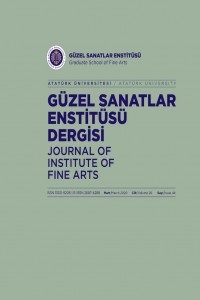Abstract
Many areas of traditional production are abandoned and the names and products of the commercial artists, who make these productions, disappear with the inclusion of computerized production. Car painting, which is performed by local artists of the period, is one of these productions. These commercial artists, who are educated in a non-formal way in mentor system, contribute not only to the urban memory and visual culture of the period, but also to determine the painting tradition of region because the artist’s style specified the style of the region. These artists paint cars, horse carriages, tractors and trailers, as well as signage when it is necessary. Considering that horse carriages were disappeared, that traditional production was abandoned and that apprentices were no longer trained, the evidence of the craftship, which almost fade into oblivion, disappear in time.
In this study, the commercial artist Enver Ertaban, who was active in Bursa between the years 1939 and 1999, is discussed. Ertaban moved his fame out of Bursa and found himself a place in documentaries and received visitors from abroad with his talent. With this study, it is aimed to document the life and the productions of Enver Ertaban, who was one of the last representatives of car painting, and to take his place in the literature.
Keywords
References
- Alp, Ö. (2010). Naif resimde sembolik kurguyu oluşturan özellikler. Atatürk Üniversitesi Güzel Sanatlar Enstitüsü Dergisi, 0(23), 15–27. Erişim adresi: https://dergipark.org.tr/tr/pub/ataunigsed/issue/2579/33172
- Kaplanoğlu, R. (2015, 13 Temmuz). Bursa’da otomobilin tarihi. Erişim adresi: http://www.bursa.com/makale/ bursada-otomobilin-tarihi-359/
- Kaplanoğlu, R. (t.y.). Bursa’da arabacılık. Erişim Adresi: http://www.bursa.com/wiki/Bursada_Arabacilik
- Karanlık, A. G. (1993). At Arabaları ve Son Ustaları. Pegasus Magazin, 5, İstanbul.
- Kurtarel, T. (Yönetmen). 1989. Araba resimleri 1. bölüm [Belgesel Film]. Türkiye: TRT. Erişim Adresi: https://www.dailymotion.com/video/x51hz2h
- Nas, E. (2005). Günümüz Konya’sında yaşayan bazı sanatlar (Doktora Tezi). YÖK Tez veri tabanından erişildi. (Tez No. 190484)
- Yazıcı, E. (1992). Bir yaprak dökümü öyküsü: Kaybolan zanaatlar. İstanbul: Ataol Yayıncılık.
- Yazıcı, E. (1993). Bursa’nın Araba Ressamı. İlgi Dergisi, 74. İstanbul.
- Yücebaş, V. (2014, 10 Nisan). Osmanlı’nın Son Yıllarından Beri Fayton Üretiyorlar, Haberler gazetesi. Erişim adresi: https://www.haberler.com/osmanli-nin-son-yillarindan-beri-fayton-5891289-haberi/
Abstract
Bilgisayarlı üretimin dahil olmasıyla, geleneksel yollarla üretim yapılan birçok alan terk edilmekte ve bu üretimi yapan sanatkarların isimleri ve ürünleri ortadan kalkmaktadır. Dönemin yerel sanatkârları tarafından icra edilen araba ressamlığı da bunlardan biridir. Eli sanata yatkın ve usta-çırak ilişkisi içerisinde formal olmayan bir yolla eğitim alan bu sanatkârlar, bir dönemin kent belleğine ve bölgenin görsel kültürüne katkı yaptığı gibi, aynı zamanda sanatkârın üslubu bölgenin üslubuna dönüştüğünden dolayı bölgenin resimleme geleneğini de belirlerler. Bu sanatkârlar at arabası, fayton, traktör, römork resimlediği gibi, gerektiğinde tabela da yazarlar. At arabalarının ortadan kalktığı, geleneksel üretimin terk edildiği ve artık çırakların yetişmediği düşünüldüğünde, unutulmaya yüz tutmuş bir sanatın kanıtları da zamanla yok olmaktadır.
Bu çalışmada, Bursa’da 1939 ilâ 1999 yılları arasında varlık gösteren ticari ressam Enver Ertaban konu edilmektedir. Ertaban, becerisiyle ünü Bursa dışına taşarak belgesellerde kendine yer bulmuş ve yurtdışından ziyaretçi kabul etmiştir. Araba ressamlığının son temsilcilerinden biri olan Enver Ertaban’ın yaşamı ve üretimleri belgelenerek literatürde yerini alması amaçlanmaktadır.
Keywords
References
- Alp, Ö. (2010). Naif resimde sembolik kurguyu oluşturan özellikler. Atatürk Üniversitesi Güzel Sanatlar Enstitüsü Dergisi, 0(23), 15–27. Erişim adresi: https://dergipark.org.tr/tr/pub/ataunigsed/issue/2579/33172
- Kaplanoğlu, R. (2015, 13 Temmuz). Bursa’da otomobilin tarihi. Erişim adresi: http://www.bursa.com/makale/ bursada-otomobilin-tarihi-359/
- Kaplanoğlu, R. (t.y.). Bursa’da arabacılık. Erişim Adresi: http://www.bursa.com/wiki/Bursada_Arabacilik
- Karanlık, A. G. (1993). At Arabaları ve Son Ustaları. Pegasus Magazin, 5, İstanbul.
- Kurtarel, T. (Yönetmen). 1989. Araba resimleri 1. bölüm [Belgesel Film]. Türkiye: TRT. Erişim Adresi: https://www.dailymotion.com/video/x51hz2h
- Nas, E. (2005). Günümüz Konya’sında yaşayan bazı sanatlar (Doktora Tezi). YÖK Tez veri tabanından erişildi. (Tez No. 190484)
- Yazıcı, E. (1992). Bir yaprak dökümü öyküsü: Kaybolan zanaatlar. İstanbul: Ataol Yayıncılık.
- Yazıcı, E. (1993). Bursa’nın Araba Ressamı. İlgi Dergisi, 74. İstanbul.
- Yücebaş, V. (2014, 10 Nisan). Osmanlı’nın Son Yıllarından Beri Fayton Üretiyorlar, Haberler gazetesi. Erişim adresi: https://www.haberler.com/osmanli-nin-son-yillarindan-beri-fayton-5891289-haberi/
Details
| Primary Language | Turkish |
|---|---|
| Journal Section | Review |
| Authors | |
| Publication Date | March 19, 2020 |
| Submission Date | December 11, 2019 |
| Published in Issue | Year 2020 Volume: 26 Issue: 44 |
Obtaining permissions for studies requiring ethics committee approval regarding the implementation of ethical rules and including information about permission in the article was added to the criteria. In this direction, Ethics Committee Permission is required for articles submitted to our journal and meeting the conditions stated below.
• Any research conducted with qualitative or quantitative approaches that require data collection from participants using questionnaires, interviews, focus group work, observation, experimentation, and interview techniques.
Also;
• Obtaining and indicating permission from the owners for the use of scales, surveys and photographs belonging to others,
• It should be stated that the copyright regulations are complied with for the intellectual and artistic works used.

